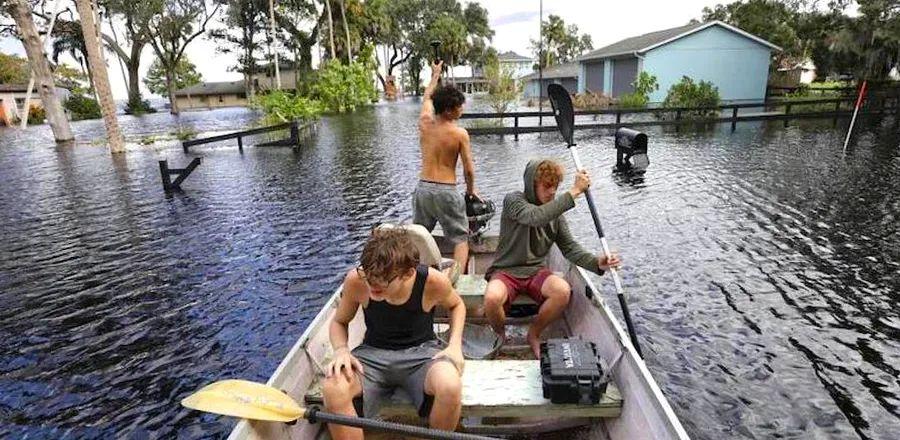The Harsh Reality in Florida Following Hurricane Ian—and How You Can Assist

Last Monday, as Tampa braced for Hurricane Ian based on all credible forecasts, I was moving everything from the ground floor of my townhouse upstairs during a mandatory evacuation and reinforcing the doors with sandbags. The situation felt surreal, akin to ‘being stalked by a turtle,’ as a viral meme humorously suggested—Florida may be a target for jokes, but it certainly knows how to make light of itself first.
While many of my neighbors evacuated to various locations across the state and even as far as Virginia, some chose to stay behind—whether due to reluctance to leave, discomfort with shelter conditions, or a lack of alternatives or means to travel.
By Tuesday, safely relocated to a friend’s home in Gainesville, around 130 miles north of Tampa with my two young children, I noticed that the storm's path had shifted east and further south, now threatening the Fort Myers area. Yet, feeling relieved that the storm had missed my home while heading toward devastation elsewhere is hardly a comforting sentiment.
On Wednesday, gathered at my friend's house, we collectively gasped at the live coverage from the Weather Channel showing the storm surge in Fort Myers Beach. My six-year-old son innocently asked if it was a tsunami. Later that day, a friend residing in Fort Myers, known for its picturesque sandy beaches, sent pictures of her pool furniture inundated by the Caloosahatchee River. Soon after, her dock was completely swept away, resembling Class V rapids. Her children are now out of school indefinitely, with their town in ruins around them.
As daylight broke on Thursday, the storm moved through central Florida on its way back into the Atlantic, heading north toward a second U.S. landfall in South Carolina as a Category 1 hurricane. It became evident that the destruction in Florida was both extensive and catastrophic.
In the ensuing hours and days, we witnessed footage from Fort Myers Beach resembling a war zone, locals in shock surveying the destruction, and learned that the idyllic vacation islands of Sanibel and Captiva had become isolated after the causeway connecting them to the mainland was washed away and collapsed due to the storm surge.

Photo by Gerald Herbert/AP
It has been a week since Hurricane Ian unleashed its catastrophic Category 4 strength and 150-mile-per-hour winds upon southwest Florida on September 28, following its devastating impact on Cuba's Pinar del Río region en route.
Alongside the devastation in southwest Florida, severe flooding occurred in various areas of central and eastern Florida due to record rainfall, potentially marking this as Florida's most costly storm in history.
Based on research concerning uninsured losses, the financial impact of Ian is estimated to reach as high as $47 billion. The human cost is still being calculated—by the latest reports, storm-related fatalities had reached 109 (with 105 of those in Florida) and the number continues to rise. Moreover, the profound disruptions to lives, particularly in areas from Sanibel Island and Fort Myers to central Florida and east coast beach towns in Volusia and Flagler counties, impacted by significant flooding, pose challenges that are far more difficult to quantify as residents confront the daunting task of rebuilding their lives.

Photo by Joe Burbank/Orlando Sentinel via AP
As a Floridian, the threat of hurricanes during the Atlantic hurricane season, which spans from June 1 to November 30, is an inherent part of life here, much like the abundant sunshine. More often than not, we manage to escape unscathed. However, Ian was the storm we had all been dreading.
In Fort Myers Beach, one of the areas most severely impacted by Ian’s fury, officials estimate that over 80 percent of the buildings will need to be reconstructed, as entire neighborhoods have been virtually erased by the storm surge.
To the north, the roads linking Pine Island to the mainland have also been obliterated, leaving the island reachable only by boat (if you can locate one that survived the storm). A temporary bridge to reconnect Pine Island residents to the mainland is expected to be completed by the end of this week, but it represents only a fraction of the extensive rebuilding required in this region of Florida in the months and years ahead.
Away from the picturesque beaches, in lower-income neighborhoods that seldom attract Florida’s tourists—including Harlem Heights, a predominantly Hispanic community situated between Fort Myers Beach and Cape Coral, where the median income was below $26,000 in 2020—conditions remain grim following Ian’s devastating floods and winds. Volunteers continue to arrive to replenish the local food pantry that was flooded and to distribute water and meals.

Photo by Scott Clause/The News-Press via AP
At the peak of the storm-related outages, over 2.5 million residents in Florida were without electricity. Approximately 42,000 linemen—the skilled workers tasked with the repair, maintenance, and installation of high-voltage power lines in both normal and crisis situations—are diligently working to restore power to affected communities. This extensive effort may take weeks or even months to complete. A friend in Naples reported that many exhausted linemen, lacking shelter or bathing facilities, are sleeping in their trucks, while locals are collecting wet wipes and deodorant for them.
On Sunday, Florida Governor Ron DeSantis’s office announced that over 1,600 rescues had been conducted across Florida so far, with more than 1,000 team members actively engaged in ongoing search and rescue efforts.
Beyond the figures reported in the media, personal stories are circulating on social media within Florida communities—such as a mother, Callie Brown, and her partner who discarded Christmas decorations from plastic bins as water surged to their attic, loading their three-month-old son and cat to swim for safety down what used to be their street. Residents are also warning against swimming in the once pristine Gulf of Mexico waters, where bodies have been observed floating. This tragedy will unfold in the days and weeks ahead, especially with nearly two months still remaining in the hurricane season.

Photo by Chris O’Meara/AP
Ways to Support the People of Florida
If you reside in Florida or have ties to the state, your social media feeds are likely brimming with opportunities to assist hurricane victims right now—from neighbors delivering supplies to southwestern Florida, to Facebook parent groups organizing fundraisers, diaper drives, and neighborhood lemonade stands run by children, with local businesses donating their proceeds. The Florida Disaster Fund (a private fund managed by the state) reportedly raised $21 million for relief efforts within the first 48 hours of its activation.
For those observing the devastation from Dinogo and seeking ways to contribute, notable organizations aiding recovery efforts include major aid groups such as the Red Cross and United Way Worldwide. Additionally, consider supporting grassroots initiatives currently underway in Florida to effectively direct your money and time to the individuals and communities that need it most. If you’re interested in volunteering, it’s advisable to collaborate with an official group of organized volunteers (like All Hands and Hearts mentioned below) and to inquire about housing arrangements in advance, as they may be limited.
Ian Response Fund
The Ian Response Fund is backed by a coalition of grassroots organizations (including Dream Defenders, Florida Rising, and Florida Immigrant Coalition) that came together in the aftermath of Hurricane Irma to raise nearly $2 million in aid. Its mission is to deliver emergency assistance, collaborating closely with organizations within the affected communities.
Metropolitan Ministries
The commercial kitchen of Tampa-based Metropolitan Ministries is partnering with chef José Andrés and the team from World Central Kitchen, utilizing their facilities as a preparation and distribution center for thousands of meals destined for those in the impacted areas of Florida. You can contribute either financially or by volunteering your time to assist with operations in Tampa through Metropolitan Ministries or directly with World Central Kitchen, which opened an additional kitchen in Fort Myers this week.
Collaboratory
Situated in Fort Myers, the Southwest Florida community foundation known as Collaboratory collaborates with the United Way of Lee, Hendry, and Glades counties to gather and allocate funds to regions with the most pressing needs, ensuring that 100 percent of its resources go to southwest Florida nonprofit organizations that are directly aiding those affected by Hurricane Ian.
Harry Chapin Food Bank of Southwest Florida
If you find yourself in the Fort Myers area and wish to lend a hand, you can either volunteer on-site or contribute to the largest hunger-relief organization in southwest Florida—the Harry Chapin Food Bank of Southwest Florida. They are currently providing ready-to-eat meals, bottled water, fresh produce, and non-perishable food to those affected at various locations in Bonita Springs, Fort Myers, Cape Coral, Naples, and beyond.
Captains for Clean Water
Another grassroots organization based in Fort Myers, Captains for Clean Water, founded by Florida fishing guides in 2016, is establishing drop-off locations across Florida, including cities like St. Pete, Jupiter, Melbourne, and Islamorada, to gather essential supplies (from generators and chainsaws to batteries and pet food) for those in need. You can also contribute directly to Captains for Clean Water’s Hurricane Ian Relief Fund, which allocates all donations to essential supplies and support.
All Hands and Hearts
This organization has provided assistance in Haiti, Nepal, and Louisiana following various natural disasters and is currently forming a volunteer Hurricane Ian Relief Team in Florida, set to welcome volunteers from October 7 through January 7, 2023, to aid in cleanup, rebuilding, and addressing community needs. If volunteering isn't an option for you, consider making a donation to support their efforts.
Evaluation :
5/5



